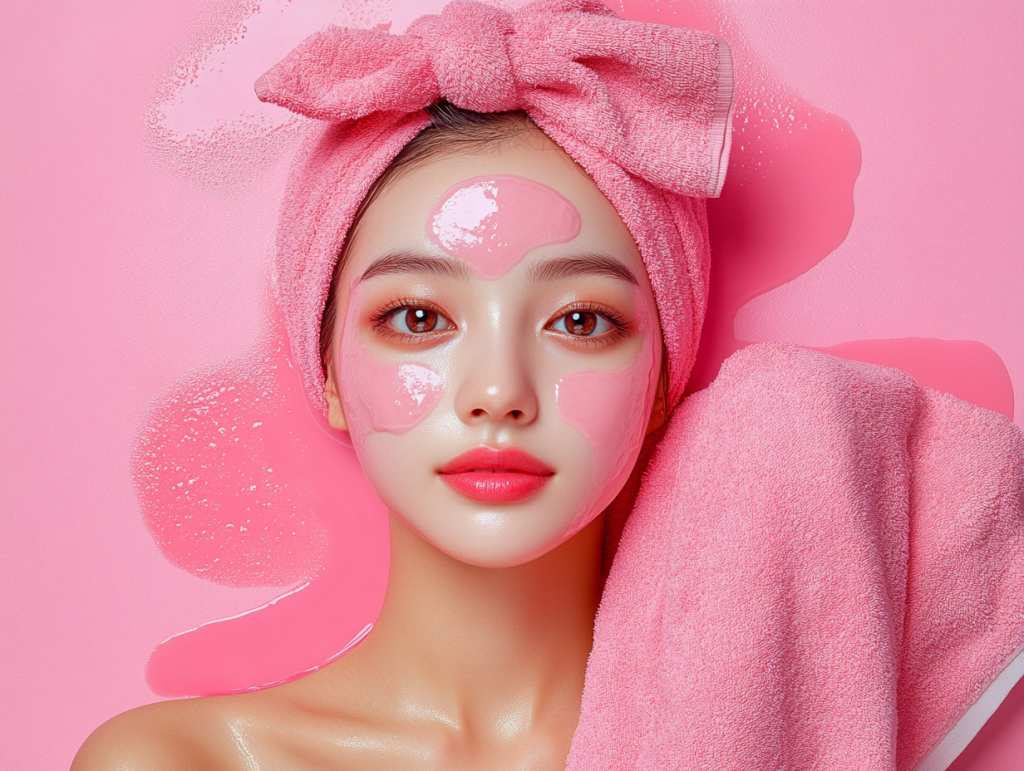
K-Beauty Skincare Secrets: The Complete Guide to the 10-Step Korean Skincare Routine
March 15, 2025
When South Korean skincare products began gaining international attention around 2015, many Western beauty enthusiasts were initially overwhelmed by what seemed like an impossibly elaborate routine. Fast forward to today, and the Korean approach to skincare has revolutionized global beauty standards, introducing concepts like “glass skin” and transforming how millions approach their daily skincare regimens.
The famous 10-step Korean skincare routine isn’t just about using more products—it’s a philosophy that prioritizes prevention over correction, gentle nourishment over harsh treatments, and consistency over quick fixes. At its core lies a profound understanding that beautiful skin is healthy skin, and achieving it requires intentional, sustained care rather than temporary solutions.
In this comprehensive guide, we’ll explore each step of the traditional Korean skincare routine, the science-backed ingredients that make K-beauty so effective, and how to adapt this approach for different skin types and concerns. Whether you’re a K-beauty novice or looking to refine your existing routine, this guide will help you navigate the world of Korean skincare with confidence.
The Philosophy Behind K-Beauty
Before diving into the specific steps, it’s important to understand the fundamental principles that distinguish Korean skincare from other approaches:
Prevention Over Correction
Korean skincare emphasizes preventing skin damage before it occurs rather than correcting existing problems. This proactive approach includes diligent sun protection, early introduction of anti-aging ingredients, and consistent hydration to maintain skin barrier health.
Gentle, Consistent Care
Rather than relying on intense treatments that might cause irritation, K-beauty favors gentle formulations used consistently over time. This philosophy acknowledges that skin is a living organ that responds better to nurturing than to aggressive intervention.
Customization and Listening to Your Skin
The 10-step routine isn’t meant to be followed rigidly every day by everyone. Instead, K-beauty encourages adjusting your routine based on your skin’s changing needs—using more hydrating products when skin feels dry, incorporating calming ingredients during breakouts, and scaling back when skin needs a rest.
Hydration at Every Level
Korean skincare recognizes that truly healthy skin requires hydration at multiple levels, which is why the routine incorporates several hydrating layers rather than relying on a single moisturizing step.
Sensory Experience and Self-Care
The routine isn’t designed merely as a series of treatments but as a ritualistic self-care practice. The textures, scents, and application methods are intended to create a mindful, enjoyable experience that nurtures both skin and spirit.
The Complete 10-Step Korean Skincare Routine
Now, let’s explore each step of the traditional routine in detail, understanding its purpose and how to select the right products for your needs.
Step 1: Oil Cleanser
The foundation of the Korean skincare routine begins with oil cleansing, which works on the principle that “like dissolves like.”
Purpose: Oil cleansers effectively dissolve oil-based impurities that water-based cleansers can’t adequately remove, including:
- Sebum (your skin’s natural oils)
- Sunscreen (particularly physical/mineral formulations)
- Makeup (especially long-wearing or waterproof products)
- Environmental pollutants that bind to oils on the skin’s surface
Application: Apply to dry skin with dry hands, massage gently for 1-2 minutes focusing on areas with makeup or excess oil, then emulsify with water until milky before rinsing thoroughly.
Key Ingredients to Look For:
- For sensitive skin: Lightweight oils like jojoba or grape seed
- For acne-prone skin: Tea tree-infused cleansing oils
- For mature skin: Antioxidant-rich oils like camellia or rice bran
Step 2: Water-Based Cleanser
The second cleansing step ensures complete removal of remaining impurities without stripping the skin.
Purpose: Water-based cleansers remove water-soluble impurities including:
- Sweat and its dissolved contents
- Any remaining traces of the oil cleanser
- Environmental pollutants that bind to water
- Dead skin cells that have loosened during oil cleansing
Application: Apply to dampened skin, gently massage with fingertips using upward circular motions, and rinse thoroughly with lukewarm (never hot) water.
Key Formulations:
- Foam cleansers: Best for oily or combination skin
- Gel cleansers: Suitable for most skin types, particularly good for acne-prone skin
- Cream cleansers: Ideal for dry or sensitive skin
- Powder cleansers: Great for customizable cleansing intensity and travel
Step 3: Exfoliation
Unlike daily cleansing steps, exfoliation is performed 1-3 times weekly depending on skin needs and product strength.
Purpose: Exfoliation accelerates the skin’s natural shedding process by removing dead skin cells that can:
- Cause dullness and rough texture
- Clog pores leading to breakouts
- Prevent proper absorption of skincare products
- Contribute to uneven skin tone
Types of Exfoliants:
- Physical exfoliants: Contain fine particles or fibers that mechanically remove dead skin cells. In K-beauty, these tend to be extremely gentle, often using ingredients like crushed seeds, rice powder, or konjac fibers.
- Chemical exfoliants: Use acids or enzymes to dissolve the bonds between dead skin cells. Korean formulations typically feature lower concentrations than Western products, emphasizing gentle, regular exfoliation over intensive treatments.
Key Ingredients:
- AHAs (Alpha Hydroxy Acids): Water-soluble acids like glycolic and lactic acid that work on the skin’s surface, ideal for addressing texture and hyperpigmentation
- BHAs (Beta Hydroxy Acids): Oil-soluble acids like salicylic acid that penetrate into pores, making them excellent for acne-prone skin
- PHAs (Polyhydroxy Acids): Larger molecule acids that provide gentle exfoliation suitable for sensitive skin
- Enzymes: Typically derived from fruits like papaya (papain) or pineapple (bromelain), these offer very gentle exfoliation by breaking down proteins in dead skin cells
Step 4: Toner
Korean toners differ significantly from traditional Western astringent toners, focusing on hydration rather than additional cleansing.
Purpose: K-beauty toners serve multiple functions:
- Balancing the skin’s pH after cleansing
- Providing the first layer of hydration
- Prepping the skin to better absorb subsequent products
- Delivering water-soluble active ingredients
Application: Pour into clean palms or saturate a cotton pad, then gently press or pat into skin rather than wiping. Many people use the “7-skin method” (applying seven thin layers of toner) when skin needs extra hydration.
Key Ingredients:
- Hyaluronic acid: Attracts and holds water for intense hydration
- Green tea: Provides antioxidant protection and soothes irritation
- Centella asiatica: Calms inflammation and supports skin barrier function
- Rice extract: Brightens and nourishes the skin
- Licorice root: Helps reduce hyperpigmentation and soothes irritation
Step 5: Essence
Often considered the heart of Korean skincare, essences are lightweight but concentrated formulations.
Purpose: Essences deliver hydration and active ingredients deep into the skin while being easily absorbed. They typically focus on:
- Cell turnover support
- Intense hydration
- Barrier strengthening
- Preparing skin for optimal absorption of serums and ampoules
Application: Pour a small amount into palms, warm between hands, then press and pat gently into skin until fully absorbed.
Key Ingredients:
- Fermented ingredients: Such as galactomyces or saccharomyces, which provide nutrients and support skin health
- Snail mucin: Contains growth factors, peptides, and antioxidants for healing and hydration
- Propolis: Offers antibacterial properties and supports wound healing
- Beta-glucan: Provides deep hydration and skin-soothing benefits
Step 6: Treatments (Serums and Ampoules)
These concentrated formulations target specific skin concerns with higher percentages of active ingredients.
Purpose: Serums and ampoules deliver powerful active ingredients to address specific concerns such as:
- Hyperpigmentation and uneven skin tone
- Fine lines and wrinkles
- Acne and breakouts
- Redness and sensitivity
Difference Between Serums and Ampoules: Ampoules are essentially super-concentrated serums, often used for intensive treatment periods rather than daily use.
Application: Apply 2-3 drops to specific areas of concern or all over the face, gently patting to aid absorption. Multiple serums can be used to address different concerns, applying from thinnest to thickest consistency.
Key Ingredients:
- Vitamin C: For brightening and antioxidant protection
- Niacinamide: For pore refinement, oil control, and brightening
- Peptides: For supporting collagen production and skin firmness
- Galactomyces: For overall skin health and radiance
- Centella asiatica derivatives: For calming inflammation and supporting healing
Step 7: Sheet Masks
Sheet masks are single-use fabric or hydrogel sheets soaked in essence or serum, designed to create an occlusive environment that maximizes ingredient absorption.
Purpose: Sheet masks provide intensive treatment by:
- Creating a physical barrier that prevents evaporation
- Forcing ingredients to absorb into skin rather than evaporating
- Providing a relaxing, spa-like experience
- Delivering immediate results for special occasions
Application: Applied after serums but before moisturizer, sheet masks typically remain on the face for 15-20 minutes (never until dry, as this can actually dehydrate skin).
Frequency: While daily masking is popular in Korea, most people use sheet masks 1-3 times weekly or when skin needs a boost.
Key Types:
- Cotton or paper masks: The most common and economical option
- Hydrogel masks: More adherent and cooling, these better deliver ingredients
- Biocellulose masks: Made from fermented coconut water, these offer excellent adherence and penetration
- Tencel or cupra fiber masks: Environmentally friendly options with good adherence
Step 8: Eye Cream
The thin, delicate skin around the eyes requires specialized care with targeted formulations.
Purpose: Eye creams are formulated to address concerns specific to the eye area:
- Fine lines and wrinkles
- Puffiness and fluid retention
- Dark circles
- Dryness and crepiness
Application: Use ring finger (which naturally applies the least pressure) to gently tap product around the orbital bone, avoiding getting too close to eyes themselves.
Key Ingredients:



